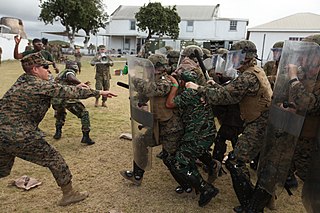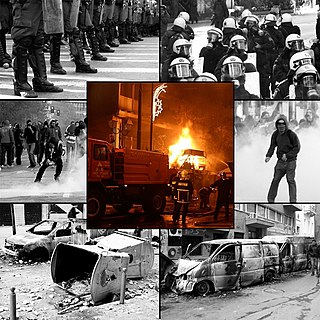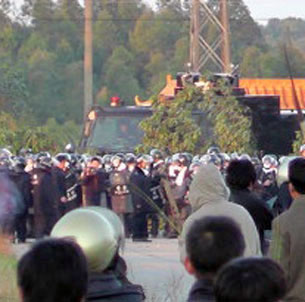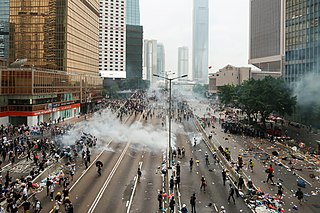
Riot control measures are used by law enforcement, military, paramilitary or security forces to control, disperse, and arrest people who are involved in a riot, unlawful demonstration or unlawful protest.

Lufeng, alternately romanized as Lukfung in Cantonese, is a county-level city in the southeast of Guangdong province, administered as a part of the prefecture-level city of Shanwei. It lies on the mainland on coast of the South China Sea east of Hong Kong.
The Dongzhou protests refers to a series of protests that took place for seven months until December 2005 in Dongzhou (东洲), a subdistrict in Shanwei prefecture, Guangdong Province, China. The protests were organized in opposition to government plans to partially infill the bay and build a new power plant. It resulted in the shooting deaths of several residents in the night of 6 December 2005 by People's Armed Police. The death toll is unknown, with different sources mentioning anywhere from three to several dozen deaths. The protests resumed in November 2006.

The 2008 Tibetan unrest, also referred to as the 2008 Tibetan uprising in Tibetan media, was a series of protests and demonstrations over the Chinese government's treatment and persecution of Tibetans. Protests in Lhasa, the capital of Tibet, by monks and nuns on 10 March have been viewed as the start of the demonstrations. Numerous protests and demonstrations were held to commemorate the 49th anniversary of the 1959 Tibetan Uprising Day, when the 14th Dalai Lama escaped from Tibet. The protests and demonstrations spread spontaneously to a number of monasteries and throughout the Tibetan plateau, including into counties located outside the designated Tibet Autonomous Region. The arrest of monks at Labrang Monastery increased the tension of the situation. Clashes occurred between Tibetans and Chinese Han and Hui residents, resulting in Han and Hui stores and buildings being destroyed and numerous Chinese civilians being injured or killed.
The 2008 Lhasa riots, also referred to as the March 14 riots or March 14 incident in Chinese media, was one of a number of violent protests that took place during the 2008 Tibetan unrest.

The 2008 Greek rebellion started on 6 December 2008, when Alexandros Grigoropoulos, a 15-year-old Greek student, was killed by a special officer in Exarcheia district of central Athens. The killing of the young student by police resulted in large protests and demonstrations, which escalated to widespread rioting, with numerous rioters damaging property and engaging riot police with Molotov cocktails, stones and other objects. Demonstrations and rioting soon spread to several other cities, including Thessaloniki, the country's second-largest city, and international cities in solidarity. Newspaper Kathimerini called the rioting "the worst Greece has seen since the restoration of democracy in 1974".
The word serhildan describes several Kurdish protests and uprisings since the 1990s that used the slogan "Êdî Bese" ("Enough") against Türkiye. Local shops are often closed on the day of demonstrations as a form of protest.

The 2011 Djiboutian protests were widespread demonstrations and riots that took place between January and March 2011 in Djibouti, situated in the Horn of Africa. A member of the Arab League, the protests in Djibouti showed a clear influence from the concurrent Arab Spring protests in North Africa and the Arabian peninsula. The demonstrations ended after mass arrests and the barring of international observers.

The 2011–2013 protests in Sudan began in January 2011 as part of the Arab Spring regional protest movement. Unlike in other Arab countries, popular uprisings in Sudan had succeeded in toppling the government prior to the Arab Spring in 1964 and 1985. Demonstrations in Sudan however were less common throughout the summer of 2011, during which South Sudan seceded from Sudan, but resumed in force later that year and again in June 2012, shortly after the government passed its much criticized austerity plan.
The Kuwaiti protests refers to the series of 2011–2012 demonstrations for government reforms in the state of Kuwait. In November 2011, the government of Kuwait resigned in response to the protests, making Kuwait one of several countries affected by the Arab Spring to experience major governmental changes due to unrest. The protests began with stateless people (Bedoon).
The 2011 Yunnan protest occurred from March 25 to March 29, 2011, in Suijiang County, Yunnan, People's Republic of China. This event, formally known as the 2011 Yunnan Protest, occurred as a land dispute after the government seized land which was to be grounds for the development of a new power plant. This event was considered a land protest as the civilians protested in protection of the land they lived and worked on.
The 2011–2012 Kurdish protests in Turkey were protests in Turkey, led by the Peace and Democracy Party (BDP), against restrictions of Kurdish rights by of the country's Kurdish minority's rights. Although they were the latest in a long series of protest actions by Kurds in Turkey, they were strongly influenced by the concurrent popular protests throughout the Middle East and North Africa, and the Turkish publication Hürriyet Daily News has suggested that the popularly dubbed "Arab Spring" that has seen revolutions in Egypt and Tunisia may lead to a "Kurdish Summer" in the northern reaches of the Middle East. Protesters have taken to the streets both in Istanbul and in southeast Turkey, with some demonstrations also reported as far west in Anatolia as İzmir.
Protests began in Syria as early as 26 January 2011, and erupted on 15 March 2011 with a "Day of Rage" protest generally considered to mark the start of a nationwide uprising. The Syrian government's reaction to the protests became violent on 16 March, and deadly on 18 March, when four unarmed protesters were killed in Daraa.

The Wukan protests, also known as the siege of Wukan, was an anti-corruption protest that began in September 2011, and escalated in December 2011 with the expulsion of officials by villagers, the siege of the town by police, and subsequent détente in the village of Wukan, in the east of Guangdong province. The villagers rose up again in June 2016, but were again suppressed. The most recent rounds of clashes were in September 2016, when the former village leader Lin Zulian was sentenced to jail. The clashes were suppressed.

Haimen is a town of Chaoyang District, Shantou, in the east of Guangdong province, China, and is situated on the South China Sea coast. It administers 16 villages, and in 2005, it had a population of about 114,300 residing in a total area of 38.5 km2 (14.9 sq mi), although 10.7 km2 (4.1 sq mi) of it is ocean. In December 2011, it was the site of protests where thousands of demonstrators spoke out over plans to expand a coal-fired power plant in the town.
The Shifang protest was a large-scale environmental protest in the southwestern Chinese city of Shifang, Sichuan province, against a copper plant that residents feared posed environmental and public health risks. The protests spanned July 1-3 2012, and drew thousands of participants. Police were dispatched to break up the demonstrations, and reportedly shot tear gas and stun grenades into the crowd. Chinese authorities said some protesters stormed a government building and smashed vehicles. Images and video of the protest circulated on the microblogs and social networking websites throughout China, some showing the protesters — many of them students — badly beaten. The protests ended late on July 3rd when the local government announced that it had terminated construction of the metals plant, and released all but six protesters who had been taken into custody.

Protests against Faure Gnassingbé have occurred throughout Togo, starting when President Faure Gnassingbé assumed power after the death of his father Gnassingbé Eyadéma in February 2005.

The month of August 2019 in the 2019–2020 Hong Kong protests saw a continuation of protests throughout the city. Several of the peaceful daytime protests were held by social groups such as families, the elderly, and various professions. In many instances, peaceful protests occurs during the day, turning increasingly violent at night. In North Point and Tsuen Wan, white- or blue-shirted armed groups were attacking protesters, but unlike in the Yuen Long violence of 21 July they were beaten back in North Point. Protesters aimed at drawing international attention through methods such as extended sit-ins at the airport. In many occasions, an eye injury of a female protester who had served as frontline medical staff became a symbol of the protests. At the airport protests, a mainland journalist was violently tackled by protesters who did not reveal his identity to the protesters. Protesters later apologised for this incident, reducing tensions and satisfying some pro-establishment lawmakers. The Prince Edward station attack on 31 August proved to be a further landmark event in the protests.

The 12 June 2019 Hong Kong protest, also known as "612 incident". refers to an incident of intense confrontation between anti-extradition bill protesters and the Hong Kong Police Force, occurring on 12 June 2019 outside the Government Headquarters in Admiralty, Hong Kong Island. The protest was sparked by the government's introduction of the controversial Fugitive Offenders amendment bill, which was set to go through second reading on 12 June despite mass opposition.
The Togolese protests of 2012–2013 were mass uprisings against the long presidency of Faure Gnassingbé in Togo. Many were killed in the suppression of demonstrations. These protests coincided with the Arab Spring.











